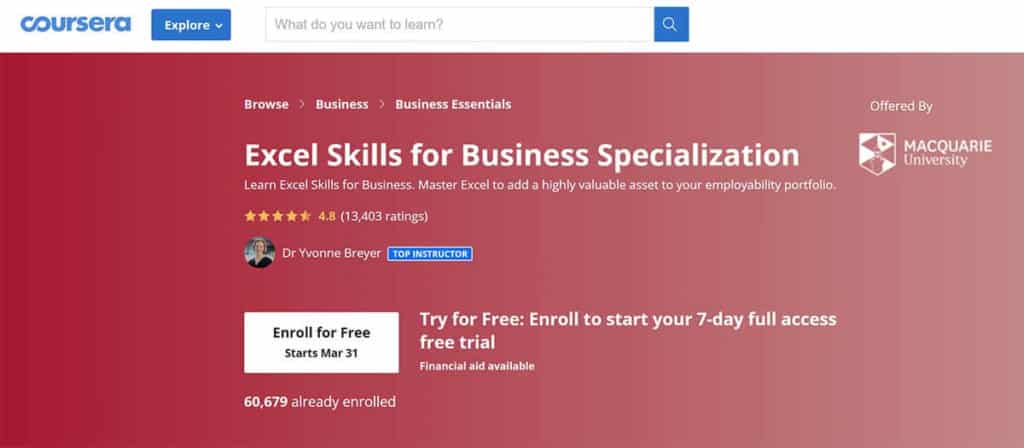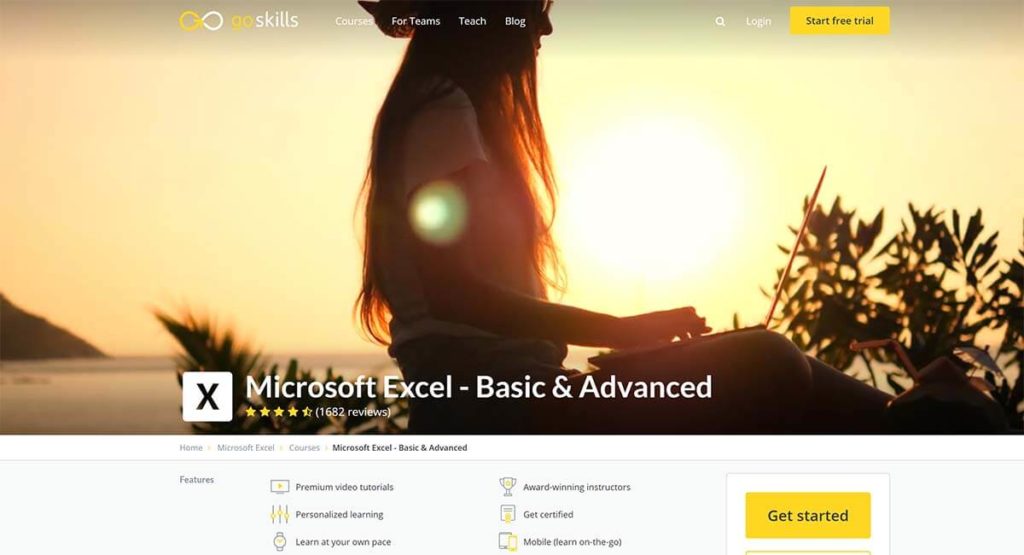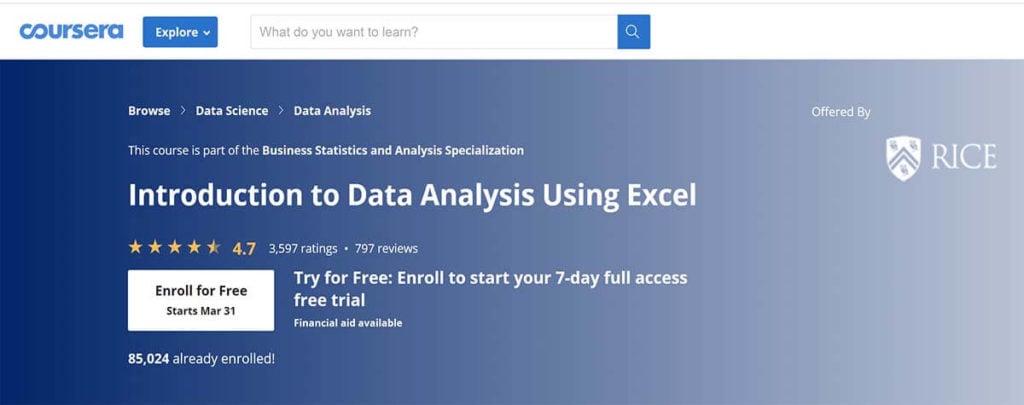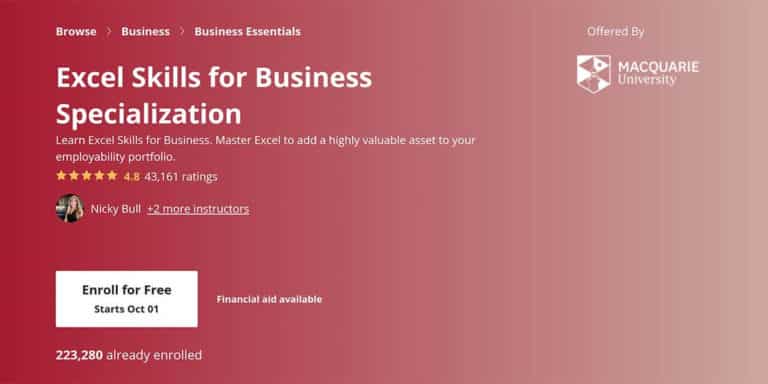Microsoft Excel proficiency is one of the most valuable skills you can have, regardless of which area you work in. Even if there is more competition in spreadsheets and data visualization, Excel is keeping up and remains a key piece of software vital to the functioning of most companies. Over a million companies use Microsoft 365 (which includes Excel), and recent market studies show that a majority of them consider Excel vital. Being a skilled Excel user will help you do your job better and, in many instances, climb the career ladder faster.
And Excel is not limited to professional use. It can also be valuable in your personal life – Excel has the ability to streamline many aspects of everyday life, such as budgeting, expense tracking, project planning, and goal setting. And why not get creative – did you know that Rivers Cuomo, frontman of Weezer, uses spreadsheets for his songwriting.
Many people can use Microsoft Excel on a basic level. Yet, very few ever master it despite great demand. This is why Excel professionals are so valuable and indispensable.
While the value of Microsoft Excel today is often underappreciated, the difficulty of learning Excel is often exaggerated. Learning Excel does not need to take weeks, months, or years. In fact, you can learn many of the core functions of Excel in a single day. That is – if you learn from a good Excel course. But if you are looking for a higher level mastery of the software, you’re going to need to put in the additional time – but with online courses, it’s relatively easy to fit this into evenings or even split out over lunch breaks.
To give you a little motivational push before you start learning your very first Excel tutorial, here’s a quick YouTube video. Here, you’ll see Sohail Anwar detailing 3 Excel-heavy jobs that pay lucrative salaries:
Now, let’s move forward to our top Excel course picks. With help from the best Excel courses on this list, you’ll learn all Excel’s most useful features: functions, data visualization tools, VBA, and more. There are superb classes on this list for all experience levels – from beginners to advanced students.
These are the best Excel courses for 2023.
Best Excel Courses
Best Overall: Excel Skills for Business Specialization (Coursera)

40% ($140 USD) off your first year of Coursera Plus Annual (expires 2 December 2024)
- Knowledgeable and articulate instructors
- Curriculum takes you from beginner to an intermediate Excel user
- Best-in-class coverage of Excel charts
- Helpful practical lessons and assessments
Cons
- Longer program that requires a significant time commitment
Coursera’s “Excel Skills for Business Specialization” is an intensive Excel program from Macquarie University. Led by three highly-rated instructors from Macquarie’s Business School – Nicky Bull, Prof Yvonner Breyer, and Dr Prashan Karunaratne – the course takes around 6 months to finish at 5 hours a week (but possible to finish faster if you prefer), providing learners with a solid understanding of how to use Excel for planning and operations for business management.
To engage learners from the get-go, the instructors interviewed international business leaders and gathered data to find common weak spots in how Excel is often used. This enabled them to develop a course outline that tackled real problem areas.
The syllabus of this program is very comprehensive and helps take students from being complete beginners in Excel at the start of the course to power users by the end. The assignments are challenging but fun, and the teaching style of Dr. Breyer is fantastic.
The course is available through the Coursera Plus subscription or can be accessed as a standalone course for $49 per month.
The quality of instruction is the main reason why this is our pick for best overall Excel course for 2023. It’s engaging, comprehensive, and suitable for beginners as well as intermediate users. While it’s lengthy, it’s more than worth the time commitment if you’re serious about Excel.
Best Crash Course: Excel Essential Training (LinkedIn Learning)

- Quick and efficient curriculum
- Suitable for beginners
- Free to access with LinkedIn Learning trial
Cons
- Small amount of material
“Excel Essential Training” is my choice for the best Excel course on LinkedIn Learning. It’s a short 2-hour Excel class that’s aimed at beginners. Yet its usefulness is not limited to novices due to an excellent instructor – Dennis Taylor.
Dennis is a renowned author and speaker on the topic of spreadsheet software and Excel. He has worked with various international corporations, and his teaching methods are tried-and-tested. He has a knack for teaching complex formulas in simple ways, and the curriculum he has built here is superb.
The teaching is clear, quick, and easily understandable. Even beginners who have never opened a spreadsheet in their life can follow the lessons. Plus, the progression of lessons feels very natural. This Excel class may be short in length, but it never manages to feel rushed, and it always remains easy to follow. At the same time, the lessons waste no time and manage to cover all essential areas for someone getting started with Excel.
The course is accessible via a LinkedIn Learning subscription, which costs $39.99 per month or $239.88 per year. However, as this is a relatively short course, you’ll have no problem completing it within the platform’s generous 30-day free trial, giving you the option to complete this high-quality Excel course for free.
All in all, this is one of the very best beginner-level Excel courses out there. It’s straightforward, and it covers all the Excel basics. It’s also worth mentioning that the Excel certificate from this course is recognized by the National Association of State Boards of Accountancy (NASBA) for continuing education credits.
Best Free Course: Excel for Beginners (edX x Davidson)
- Comprehensive beginner curriculum
- Free to audit
- Full of practical Excel tips and tricks
Cons
- Certificate of completion requires payment
“Excel for Beginners” on edX is a high-quality course developed by Davidson College. It’s 4 weeks long at an introductory level, meaning that it’s suitable for beginners who have never used Excel, and takes you through all of the basics and some intermediate topics.
Those familiar with edX online courses will know that on edX, all the course lessons are free to audit. This means that you can take all the lessons free of charge. But, without paying, you will not have access to certificates or graded assignments. Graded assignments one could live without. But, the Davidson-branded Excel certificate is a big benefit of this course, so you may want to pay the $199 if you’re planning on taking this Excel class.
Although you can also audit most Coursera courses, we consider this course the best free option, as it caters more directly to beginners and is a high-quality option for anyone looking to improve their fundamentals in Excel.
Best Medium-Length Course: Microsoft Excel - Basic & Advanced (GoSkills)

- Taught by a Microsoft Excel MVP
- Good balance between comprehensiveness and brevity
- Compatible with Office 365
Cons
- User interface is not fully streamlined
“Microsoft Excel – Basic & Advanced” on GoSkills is another superb Excel training course. It’s a 26-hour course that’s suitable for beginners and gets you to a strong intermediate level of proficiency by the end of it. This Excel class is a good middle-ground between a more comprehensive Excel course and a shorter introductory course. It’s comprehensive, but not as long as something like Coursera’s 6-month course.
Ken Puls, a Microsoft MVP since 2006, leads this training program. The MVP award is Microsoft’s way of recognizing outstanding professionals who work with Microsoft Office products. You can read Ken’s blog, Excelguru, to find out more about him and his experience with Microsoft Office.
This online course is by far Ken’s most popular course to date, and that’s for good reason. It’s full of practical tips and tricks on Excel formulas, functions, and macros. It starts off with the fundamentals of Excel use – the interface, basic functions, data sorting & filtering. Then, once students are already familiar with the basics, Ken digs deeper into Excel. He introduces more advanced topics such as Pivot Tables, conditional formatting, advanced Excel charts, data validation, and data manipulation.
The course is accessible via a GoSkills subscription, which is $29 per month or $208 per year for all courses on the platform. Note that they also offer a 7-day free trial, so you can fully test out the course before committing.
In a nutshell, this is one of the best Excel classes for students looking for a medium-length course. A course that is affordable, detail-oriented, and easy to follow.
Best for Modeling: Data Visualization with Advanced Excel (Coursera)

40% ($140 USD) off your first year of Coursera Plus Annual (expires 2 December 2024)
- Teaches advanced Excel functions and formulas
- Covers pivot tables in detail
- Led by an industry expert
Cons
- Teaches with the outdated Excel 2013
- Some exercises have errors
- Uses PowerPivot, which is not available in Excel for Mac
Another good Excel class on Coursera is “Data Visualization with Advanced Excel”. This Excel class takes around 10 hours to finish and it’s led by Alex Mannella. Alex is an Excel veteran working for PwC. He has extensive experience in big data mining and response modeling. In addition, he has expertise in data visualization, which is also one of the primary subjects in this course.
If you’d like to learn from Alex’s modeling experience, then you will find this online course a real treat. That is because Alex demonstrates some superb techniques for Excel modeling in this course. It’s categorized as a rookie-friendly course. Yet it’s not the best pick for someone with zero experience in spreadsheets. Instead, it’s best suited for someone who has basic working knowledge of Excel. Advanced skills are not necessary, but basic skills will be very beneficial.
Like the other Coursera options in this list, the course is available through the Coursera Plus subscription or can be accessed as a standalone course for $49 per month.
My only gripe with this online Excel course is that it uses the 2013 version of Microsoft Office for instruction. It’s already 2023 now, and some of the lessons could use refreshing. However, even if some things have been reorganized a bit, most, if not all, functionality covered in the course is still available in the Microsoft 365 version. And formulas that worked on past versions of Excel will work on newer versions (and mostly vice versa). Yet, as an Office 365 user, I would still prefer up-to-date material that uses the same interface that I do. Note also that the course makes use of the PowerPivot functionality, which is not available on Mac. There are also some minor errors in some of the exercises. Despite this, this training program is still the best there is when it comes to learning Excel modeling.
Best for Data Analysis: Introduction to Data Analysis Using Excel (Coursera)

40% ($140 USD) off your first year of Coursera Plus Annual (expires 2 December 2024)
- Excellent for business-related data analysis
- Suitable for beginners
- Extensive coverage of data validation and visualization
Cons
- Course lessons don’t always correspond to quizzes
If you are looking specifically at improving your data analysis skills for business purposes, “Introduction to Data Analysis Using Excel” on Coursera will be a good pick. This Excel training program, offered by Rice University, takes about 20 hours to finish and is led by Sharad Borle, an expert on business statistics and data analytics at the Jones Graduate School of Business.
For taking this course, prior basic working knowledge of Microsoft Office and Excel is beneficial, but not a necessity as this course is designed for beginners. If you want to delve deeper into business data analytics, continue with the other four courses delivered by Sharad Borle in the “Business Statistics and Analysis Specialization.”
As a standalone online class, this is one of the best Excel courses for finance. It goes deepest into topics such as pivot tables, Excel charts, conditional formatting, graphing, and data manipulation. These are must-have skills for any serious Excel user who works in business.
Like the two above Coursera options, this course is available through the Coursera Plus subscription or can be accessed as a standalone course for $49 per month.
The main negative aspect of the course is that it is lacking in course material outside of the video lessons, and some of the assignments and quizzes don’t fully line up with what is taught in the lessons – so you may need to turn to Google to look up some of the points.
If you wish to use Excel for finance and data analysis, but you are unsure of where to begin, take this course. It’s short, efficient, full of practical assignments, and it doesn’t break the bank. When it comes to using Excel for data analysis and finance, this is one of the best Excel classes out there. It’s also worth checking out our other top-rated data analytics courses if you’re interested in the topic of data analysis.
Best for VBA: Learning VBA in Excel (LinkedIn Learning)
- Laser-focused on advanced formulas
- Instructor is very experienced
- Free trial available
Cons
- Relatively small amount of course material
- Covers some functionality only available on Windows versions of Excel, such as PowerPivot
“Learning VBA in Excel” is another top Excel training program on LinkedIn Learning. While this introduces one of the most advanced topics in Excel – VBA or Visual Basic for Applications –it manages to do this in an effective and relatively brief way. Clocking in at only 3 hours and 14 minutes, it’s led by Curtis Frye, a renowned author on Excel.
I named it the top Excel VBA course as it manages to sufficiently cover most of the main points of VBA in Microsoft Excel for an intermediate user. It explains VBA watches, object models, subroutines, and much more. The lessons don’t waste any time on introductions. They dive straight into advanced formulas, Excel power pivot tables, and various VBA-related applications.
This class is for advanced Excel users only. Beginner Excel users will have trouble with progressing through the course lessons. For novice users, it makes much more sense to go with one of our other top-rated picks.
Like our other LinkedIn Learning pick, the course is accessible via a LinkedIn Learning subscription, which costs $39.99 per month or $239.88 per year, and you can make use of the 30-day free trial to take the course completely for free. However, unlike our other pick, this course can also be bought with lifetime access for $49.99
For adept Excel users, this course is a fantastic learning opportunity. In this course, you get the chance to learn from a seasoned user of Excel. And you get to add some advanced tips and tricks to your Excel arsenal. Note, however, that the course does cover some functionality, such as PowerPivot, that is not available in Mac versions of Excel. But for intermediate and advanced Excel users looking for an intensive and brief introduction to VBA, this is one of the top Excel classes available.
How to learn Excel online
Can a total beginner learn data science? Sure, here’s how you can learn data science online without any prior knowledge.
1. Choose an online course
While there are plenty of unstructured resources (like YouTube tutorials) online to help you learn Excel from scratch, our advice is to skip them. These kinds of tutorials can be great, but not if you are looking for a structured course that will help you cover all of the necessary related topics. Enrolling in a high-quality Excel course will give you a much more solid foundation.
Whether you’re a novice or an intermediate Excel user, a good online Excel course will teach you everything you need to know to level up. No more wasting hours of your time looking for tutorials and projects that are actually relevant to you. With an online course, you’ll have everything in one place.
This is important because one of the biggest problems individuals who want to learn Excel on their own encounter is a lack of structure. Having the correct structure in place can mean the difference between becoming an excel master and never getting beyond basic functions.
Besides, with no guidance, it’s all too easy to feel like you have to focus on everything at once. Excel has hundreds of functions, formulas, and options, but you’d be wrong to think that you need to know them all. An experienced Excel instructor can show you what is crucial and what is unnecessary.
2. Find a project to work on
Most people learn very quickly when there’s a real-life problem to be solved. While most Excel courses include projects, you’ll want to continue using the software long after finishing the course. The best way to do that is to combine Excel with something you’re interested in or enjoy doing.
Here are a few examples of projects to get you started:
- Create a weekly/monthly budget for yourself.
- Design your own task tracker.
- Catalog your music collection.
- Track your workout schedule.
- Simulate stock market investments.
3. Lose the mouse
To make the most out of Excel and boost your productivity, ditch the mouse and find out how to do the things you want to do with your keyboard instead.
Here is a list of useful keyboard shortcuts. Print it out and stick it on your wall until you familiarize yourself with the hotkeys you use the most.
4. Earn a Microsoft Office Specialist Excel Certification
Once you know how to use Excel at an advanced level, you should get a Microsoft Excel certification from Microsoft itself. To get the certificate, you’ll need to take an exam. The exam will test your ability to edit a workbook with more than one sheet and represent data visually.
A Microsoft Office Specialist Excel Certification is a great way to show your current and future employers that you’re well able to use Excel.
5. Enter Excel competitions
What better way to test your Excel knowledge than by joining an Excel competition? Even if you don’t win, you can see the areas you could improve on and gain a ton of motivation to continue your Excel journey.
If you’re a student, you can participate in the global Microsoft Office Specialist World Championship that tests your skills in Excel as well as Microsoft Word and PowerPoint.
For adults, there are plenty of financial modeling competitions where contestants have to use Excel to solve financial questions. Two examples are the Financial Modeling World Cup and the Corporate Finance Institute (CFO) Financial Modeling Competition.
6. Stay curious
As you’re doing a specific task in Excel, always ask yourself: is there an easier way to do this? Chances are, there is. Mastering Excel is all about finding the shortest path to a solution. If you Google your question, you’ll probably come across a more efficient way of performing said task.
And, if you’re ever stuck on something Excel-related and can’t find the answer by Googling your question, ask for help on an Excel forum, like Reddit’s excel subreddit.
Other resources you might find handy include Microsoft Excel Help Center, The Spreadsheet Page, and Reddit’s Excel advice thread repository.
How to choose a good Microsoft Excel course
The number one thing you should consider when choosing a Microsoft Excel course is your level of experience.
While most Microsoft Excel courses cater to total beginners, some deal with intermediate and even advanced concepts. So, before you enroll in a course, read the curriculum to make sure that it’s not too easy/difficult for you.
Here are the kinds of skills you’re looking to acquire based on your current understanding of Excel (although these are just guidelines and by no means set in stone):
- Beginner: Basic formulas, tables, and graphs.
- Intermediate: Pivot tables, SUMIFS, INDEX MATCH, VLOOKUP.
- Advanced: Macros, VBA, data modeling, DAX.
The next thing you should look at is who teaches the course. What is the instructor’s experience with Excel? Are they a professional lecturer? Or are they a professional in their chosen field? And what kind of credentials do they have? You want to learn from the best of the best — especially if you’re paying money.
Examine the reviews left by past students, as well. Were they happy with the course? Was the lecturer easy to understand? Were there enough assignments and projects? These are all things you want to know before you enroll in a course.
Is Excel hard to learn?
Whether or not Excel is hard to learn depends largely on the person learning it. For example, people who are good with numbers may find it easier to learn Excel than people who are good with words.
The kind of use case you’re talking about matters, as well. While making a calendar in Excel is straightforward, creating a dashboard report for a business is more complicated.
In general, most Excel users agree that learning Excel is a gradual curve that never ends. Whatever you’re doing in Excel, there’s probably a better and more efficient way to do it, regardless of how many years of experience you have.
However, the continual learning cycle is one of the things the majority of people love most about Excel.





